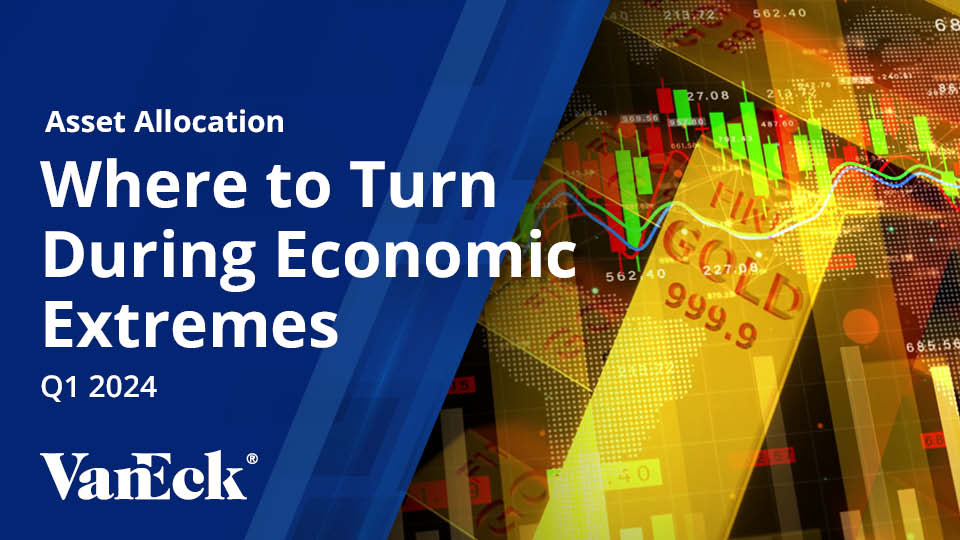Podcast: Battle-Tested Assets for All Regimes
March 28, 2023
Read Time 7 MIN
I recently enjoyed joining Jack Forehand, CFA, and Justin Carbonneau on the Excess Returns podcast for an engaging discussion. Our conversation touched on a range of topics, including my background in due diligence and a comparison between the situations faced by Paul Volcker and Jerome Powell in their respective tenures as Federal Reserve Chair (Spoiler Alert: Volcker's situation was more manageable).
Below are some highlights from our conversation:
- The Value of a Background in Due Diligence and Selecting a Fund Manager
- The Journey to Quantitative Investing
- Adapting to An Inflationary Regime: Investment Options
- Adjusting for Inflationary Conditions
- Comparing Volcker and Powell
- Microsoft and Exxon Mobil: A Tale of the Cyclical Nature of Growth and Value
- The Most Important Lessons for Investors Today
The Value of a Background in Due Diligence and Selecting a Fund Manager
A background in due diligence offers a unique opportunity to engage with accomplished fund managers with impressive track records. Conversations with these successful investment professionals can be invaluable as you can absorb valuable insights and strategies to help shape your own investment philosophies and personal style.
One key aspect to consider when evaluating a fund manager is their long-term track record of success, which demonstrates a sound investment philosophy and a strong investment process.
The Journey to Quantitative Investing
The blend of art and science in portfolio management can be seen in the balance between quantitative and fundamental strategies. Quantitative investing, which involves a market historian's perspective, allows studying past market performance to understand current trends better and predict future movements.
Quantitative strategies have the advantage of removing the emotional pitfalls that discretionary managers face, as they can sometimes be dogmatic. Merging the informational and behavioral benefits of quantitative investing with the common sense and experience of fundamental investing can create a powerful approach. Understanding that human discretion is always involved in some capacity is essential in recognizing the balance between the two methods.
Adapting to An Inflationary Regime: Investment Options
Inflation has been a concern for us for some time and the current high levels are expected to persist for an extended period. Historically, once high inflation emerges, it is difficult to resolve. Inflation may experience peaks and troughs, but the average level of inflation over time is critical to consider. The current environment may not be conducive to fighting inflation due to factors such as commodity shortages, ongoing conflicts, and a lack of political willpower.
Dealing with elevated inflation requires a change in investment strategies. While investors can manage 4 to 5% inflation, anything higher is disruptive. As we enter a new inflationary period, investors must adapt their strategies and consider assets that will perform well in this environment. With the Federal Reserve's efforts to bring inflation down, it is crucial to recognize that other factors are at play, such as global economic conditions and the current state of the commodity market. It is not solely the Fed's actions that will determine the success of investments moving forward.
Investors have various options when investing in assets that may perform well during inflationary times. Some of these include commodities, gold, certain stocks, and real estate. After extensive research on this topic, we believe these are the best assets to invest in during this period:
- Resource Assets: Commodities and Natural Resource Equities
Commodities respond quickly to supply-demand imbalances, and due to the transition from traditional energy to renewables, structural shortages are expected in the commodity complex. This could lead to elevated commodity prices for an extended period of time.
Natural resource equities, such as oil services companies and those involved in extracting, producing, and distributing commodities, are also expected to perform well. These companies benefit from higher commodity prices and have shown discipline in capital allocation.
- Financial Assets: Gold Bullion and Gold Equities
Another recommended investment is gold bullion and gold equities. Gold does not have the utility of other commodities, so people must seek it out as a store of value asset for it to work as an investment. In an inflationary environment, gold becomes an attractive option for investors looking to preserve wealth. Historically, gold has performed well during periods of inflation, as seen in the 1970s and mid-2000s. As we move later in the cycle, gold is expected to rally significantly, even independent of interest rates.
- Income Assets: Income-Generating Real Assets
Finally, income-generating real assets such as infrastructure companies, REITs, and MLPs should be considered. These investments can pass along inflation to their customers while maintaining profit margins, making them more attractive in an inflationary environment.
Adjusting for Inflationary Conditions
Investors should aim to have assets in their portfolios that can perform in various economic environments, including high growth, low growth, high inflation, and low inflation. A balanced portfolio should include an allocation to resource assets, although this allocation should be smaller than the allocation to stocks and bonds.
The traditional 60/40 portfolio of stocks and bonds may not be sufficient to protect against inflationary risks. Investors should consider allocating around 15% of their portfolio to diversified real assets, which can provide a buffer during periods of high inflation while still allowing for growth during periods of low inflation.
In periods of ultra-high inflation, it may be prudent for investors to adjust their portfolio allocations to favor assets particularly effective at protecting against inflation, such as commodities. Strategies like the VanEck Inflation Allocation ETF (RAAX) invest in a mix of resource assets, income-generating real assets, and financial assets while biasing the portfolio towards assets expected to lead the market higher during periods of inflation.
However, during periods of extended low inflation, it may be more appropriate to increase allocations to REITs and infrastructure real assets, which can perform independently of the inflation cycle. While adjusting your portfolio based on inflationary conditions is important, it's equally important not to make drastic changes based on short-term economic forecasts.
Comparing Volcker and Powell
The current situation is very different from what former Federal Reserve (Fed) Chairman Paul Volcker faced during his tenure. Volcker had the advantage of disinflationary forces like fallen commodity prices and no wars working in his favor. In contrast, current Chair Jerome Powell has these same forces working against him. This makes it challenging for Powell to maintain low inflation while also dealing with the consequences of de-globalization.
Microsoft and Exxon Mobil: A Tale of the Cyclical Nature of Growth and Value
To better understand the dynamics of free cash flow yields and company performance, examining the contrasting stories of Microsoft and Exxon Mobil is useful. Microsoft has outperformed the S&P 500 for the decade leading up to this point, while Exxon Mobil has remained relatively flat. This difference can be attributed to the significant disparity in free cash flow yields during various economic regimes.
However, expanding the analysis beyond the last decade reveals a period when Exxon Mobil significantly outperformed Microsoft. This historical context highlights the cyclical nature of growth and value investing.
Both growth and value managers have often claimed that the other investment style is "dead” at some point. However, the truth is that growth and value investing work in cycles that typically last five to ten years. We are likely in a continued value environment that will benefit those exposed to commodities.
At present, the free cash flow yields for Exxon Mobil are remarkably high. Historically, such high yields have led to above-market returns. The expectation is that this trend will continue for some time. As more investors recognize the potential in these assets, we'll likely see significant price appreciation in the coming years.
The Most Important Lessons for Investors Today
When it comes to investing, there is a wealth of research and experience to draw from. However, if we had to distill all of that knowledge into just one critical lesson for the average investor, it would be this: asset allocation is the most important decision you'll make. To navigate the ever-changing economic landscape, you must understand the four major categories of economic environments – high inflation, low inflation, high growth, and low growth – and build a stable asset allocation mix that can handle each of these regimes.
While it's natural to feel the urge to move in and out of asset classes as market conditions change, avoiding being too aggressive with tactical shifts is crucial. Making careless errors in this area can increase the time you'll need to work before achieving your financial goals. The key is to stay strategic, making only minor adjustments at the margins when necessary. Doing so can better position yourself for long-term success in the markets.
One of the most challenging aspects of investing is managing emotions during market volatility. However, it's essential to recognize that volatility is a normal investment process. Rather than being frightened by it and rushing to sell your assets, try to see volatile periods as opportunities for growth. By sticking to your strategic asset allocation and riding through these storms, you'll be better equipped to capitalize on market fluctuations and ultimately achieve your financial goals.
Watch the full podcast episode here.
To receive more Asset Allocation insights, sign up in our subscription center.
Related Topics
Related Insights
February 28, 2024
February 22, 2024
December 19, 2023
Important Disclosures
This is not an offer to buy or sell, or a recommendation to buy or sell any of the securities mentioned herein. The information presented does not involve the rendering of personalized investment, financial, legal, or tax advice. Certain statements contained herein may constitute projections, forecasts and other forward looking statements, which do not reflect actual results, are valid as of the date of this communication and subject to change without notice. Information provided by third party sources are believed to be reliable and have not been independently verified for accuracy or completeness and cannot be guaranteed. The information herein represents the opinion of the author(s), but not necessarily those of VanEck or its employees.
The S&P 500 Index consists of 500 widely held common stocks covering the leading industries of the U.S. economy.
Investments in commodities can be very volatile and direct investment in these markets can be very risky, especially for inexperienced investors.
Hard assets investments are subject to risks associated with real estate, precious metals, natural resources and commodities and events related to these industries, foreign investments, illiquidity, credit, interest rate fluctuations, inflation, leverage, and non-diversification.
Gold investments are subject to the risks associated with concentrating its assets in the gold industry, which can be significantly affected by international economic, monetary and political developments. Investments in gold may decline in value due to developments specific to the gold industry. Foreign gold security investments involve risks related to adverse political and economic developments unique to a country or a region, currency fluctuations or controls, and the possibility of arbitrary action by foreign governments, or political, economic or social instability. Gold investments are subject to risks associated with investments in U.S. and non-U.S. issuers, commodities and commodity-linked derivatives, commodities and commodity-linked derivatives tax, gold-mining industry, derivatives, emerging market securities, foreign currency transactions, foreign securities, other investment companies, management, market, non-diversification, operational, regulatory, small- and medium-capitalization companies and subsidiary risks.
Concentrating assets in the real estate sector or REITs may disproportionately subject a portfolio to the risks of that industry, including the loss of value because of adverse developments affecting the real estate industry and real property values. Investments in REITs may be subject to increased price volatility and liquidity risk; concentration risk is high.
VanEck Inflation Allocation ETF (RAAX): An investment in the Fund may be subject to risks which include, among others, risks related to investing in real assets ETPs, which may subject the Fund to commodities, gold, natural resources companies, MLPs, real estate sector, infrastructure, ETP-related equity securities, small- and medium-capitalization companies, foreign securities, emerging market issuers, ETP-related foreign currency, credit, interest rate, call, concentration and derivative risks, all of which may adversely affect the Fund. The Fund may also be subject to fund of funds, affiliated fund, U.S. Treasury Bills, subsidiary investment, commodity regulatory (with respect to investments in the Subsidiary), tax (with respect to investments in the Subsidiary), cryptocurrency, cryptocurrency tax, liquidity (with respect to commodities instruments), gap, cash transactions, high portfolio turnover, models and data, active management, operational, authorized participant concentration, no guarantee of active trading market, trading issues, market, fund shares trading, premium/discount and liquidity of fund shares, and non-diversified risks. Foreign investments are subject to risks, which include changes in economic and political conditions, foreign currency fluctuations, changes in foreign regulations, and changes in currency exchange rates which may negatively impact the Fund's returns. Small- and medium-capitalization companies may be subject to elevated risks.
Investing involves substantial risk and high volatility, including possible loss of principal. An investor should consider the investment objective, risks, charges and expenses of the Fund carefully before investing. To obtain a prospectus and summary prospectus, which contains this and other information, call 800.826.2333 or visit vaneck.com. Please read the prospectus and summary prospectus carefully before investing.
© Van Eck Securities Corporation, Distributor, a wholly owned subsidiary of Van Eck Associates Corporation.
Related Funds
Important Disclosures
This is not an offer to buy or sell, or a recommendation to buy or sell any of the securities mentioned herein. The information presented does not involve the rendering of personalized investment, financial, legal, or tax advice. Certain statements contained herein may constitute projections, forecasts and other forward looking statements, which do not reflect actual results, are valid as of the date of this communication and subject to change without notice. Information provided by third party sources are believed to be reliable and have not been independently verified for accuracy or completeness and cannot be guaranteed. The information herein represents the opinion of the author(s), but not necessarily those of VanEck or its employees.
The S&P 500 Index consists of 500 widely held common stocks covering the leading industries of the U.S. economy.
Investments in commodities can be very volatile and direct investment in these markets can be very risky, especially for inexperienced investors.
Hard assets investments are subject to risks associated with real estate, precious metals, natural resources and commodities and events related to these industries, foreign investments, illiquidity, credit, interest rate fluctuations, inflation, leverage, and non-diversification.
Gold investments are subject to the risks associated with concentrating its assets in the gold industry, which can be significantly affected by international economic, monetary and political developments. Investments in gold may decline in value due to developments specific to the gold industry. Foreign gold security investments involve risks related to adverse political and economic developments unique to a country or a region, currency fluctuations or controls, and the possibility of arbitrary action by foreign governments, or political, economic or social instability. Gold investments are subject to risks associated with investments in U.S. and non-U.S. issuers, commodities and commodity-linked derivatives, commodities and commodity-linked derivatives tax, gold-mining industry, derivatives, emerging market securities, foreign currency transactions, foreign securities, other investment companies, management, market, non-diversification, operational, regulatory, small- and medium-capitalization companies and subsidiary risks.
Concentrating assets in the real estate sector or REITs may disproportionately subject a portfolio to the risks of that industry, including the loss of value because of adverse developments affecting the real estate industry and real property values. Investments in REITs may be subject to increased price volatility and liquidity risk; concentration risk is high.
VanEck Inflation Allocation ETF (RAAX): An investment in the Fund may be subject to risks which include, among others, risks related to investing in real assets ETPs, which may subject the Fund to commodities, gold, natural resources companies, MLPs, real estate sector, infrastructure, ETP-related equity securities, small- and medium-capitalization companies, foreign securities, emerging market issuers, ETP-related foreign currency, credit, interest rate, call, concentration and derivative risks, all of which may adversely affect the Fund. The Fund may also be subject to fund of funds, affiliated fund, U.S. Treasury Bills, subsidiary investment, commodity regulatory (with respect to investments in the Subsidiary), tax (with respect to investments in the Subsidiary), cryptocurrency, cryptocurrency tax, liquidity (with respect to commodities instruments), gap, cash transactions, high portfolio turnover, models and data, active management, operational, authorized participant concentration, no guarantee of active trading market, trading issues, market, fund shares trading, premium/discount and liquidity of fund shares, and non-diversified risks. Foreign investments are subject to risks, which include changes in economic and political conditions, foreign currency fluctuations, changes in foreign regulations, and changes in currency exchange rates which may negatively impact the Fund's returns. Small- and medium-capitalization companies may be subject to elevated risks.
Investing involves substantial risk and high volatility, including possible loss of principal. An investor should consider the investment objective, risks, charges and expenses of the Fund carefully before investing. To obtain a prospectus and summary prospectus, which contains this and other information, call 800.826.2333 or visit vaneck.com. Please read the prospectus and summary prospectus carefully before investing.
© Van Eck Securities Corporation, Distributor, a wholly owned subsidiary of Van Eck Associates Corporation.



